Umbrian Settlement
Evidence for the early settlement of the modern city has been found near the church of Sant’ Andrea, the site of the Roman forum (see below). Thus Manconi, Camerieri and Cruciani (referenced below, at p. 377) and Dorica Manconi (referenced below, at pp. 208-9) described ceramic objects (7th - 4th centuries BC) at the lowest level of the excavations.
Necropoles
The archeological collection exhibited in Palazzo Bianconi includes a display of grave goods from what seems to have been a large necropolis that extended from the city gate of Portonaccio along Via Baldini towards the railway station. Many of its graves had been disturbed by the tome of their excavation in 1977-9, either by earlier clandestine excavation or by natural phenomena. According to Dorica Manconi (referenced below, at p. 207), the surviving grave goods suggested that this necropolis had been in use in the period in the 7th-1st centuries BC. However, Paul Fontaine (referenced below, at p. 245) observed that most of the tombs dated to the 3rd or 2nd century BC.
The excavation was carried in two phases:
-
✴In 1977, attention focused on two inhumation tombs (designated tombs 1 and 10) near Portonaccio which were essentially undisturbed.
-
•The grave goods in Tomb 1 included a pair of dice and two coins produced in 217-5 BC.
-
•The grave goods in Tomb 10 belonged to a noble lady, and included three coins, one of which has been dated to 179 BC, as well as her mirror and perfume flask (below)
-
•A fibula (7th century BC) was found nearby.
-
✴An older inhumation tomb (ca. 300 BC) was discovered 1979, during the excavation of a Roman villa in Via Baldini (to the south). Some of the grave goods had been imported from Etruria.
Dorica Manconi (referenced below, at p. 207), who described other finds the necropolis above, also referred to finds from a second necropolis at Santa Luciola (on the road between Spello and Assisi/Perugia) that was in use in the 5th century BC.
Sanctuary at Villa Fidelia
The Roman sanctuary at Villa Fidelia, below the walls of the modern city, is described in detail below. Manconi, Camerieri and Cruciani (referenced below, p. 391, note 54) recorded the discovery in 1990, during emergency excavations on a site at the south west edge of the Roman theatre (see below), of:
-
“... a votive bronze in the form of a hand, typical for Umbrian sanctuaries of 5th and 4th centuries BC, found in the deeper strata [of the excavations]...” ( my translation).
This votive bronze constitutes the only evidence so far for early cult practices on the site.
[More about the possibility that an earlier sanctuary here served an ancient pan-Umbrian federation. Mevania 308 BC - original sanctuary might have belonged to Mevania until the formation of the colony]
Romanisation
Paul Fontaine (referenced below, at p. 245) observed that:
-
“The history of Spello is ... poorly documented for the period prior before the 1st century BC. ... Most of the tombs [in the necropolis at Portonaccio, discussed above] date to the 3rd or 2nd century BC, and this is also the date of the the oldest vestiges of [urbanisation] discovered .. on the site of Spello” (my translation)
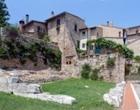
-
“The area of the forum near Sant’ Andrea di Spello (a long artificial terrace running north-south) began to the urbanised between the late 3rd and the 2nd century. The retaining wall of the the terrace is in opera quadrata, with blocks of local limestone laid without cement on the underlying rock” (my translation).
This early urbanisation of the city was probably stimulated by the formation of the Roman colony of Spoletium in 241 BC and the building of Via Flaminia (which passed within 2 km of the city) in 220 BC. Other evidence of urbanisation at this time was found:
-
✴near the the nearby church of San Filippo, during the restructuring in 1991 to form the present Post Office; and
-
✴during excavations near Porta Consolare in 1977, revealed traces of the road from this period that ran through the city from north to south.
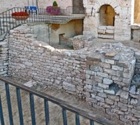
Umbrian Inscriptions
The numbers in square brackets in the subtitles below refer to the individual entries in the catalogue “Screhto Est”, edited by L. Agostiniani, (referenced below ).
Votive Altar of Jupiter (3rd century BC ?) [27]
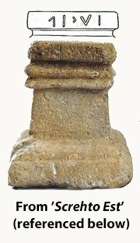
iuvip(atre)
This probably refers to the god Jove the Father, or Jupiter. [Is it exhibited at the Museo Archeologico at Perugia ??]
There is some uncertainty about the date of the inscription:
-
✴Alberto Calderini (in L. Agostiniani, referenced below, entry 27) dated the alphabet used in it to the period between the mid 3rd century and the early 2nd century BC, although he conceded that there was some uncertainty.
-
✴Simone Sisani (referenced below, 2012, at p. 424 and note 86) regarded this as too late, and alternatively dated it to the 4th or 3rd century BC.
Dorica Manconi (also in Entry 27) asserted that the altar almost certainly supported a small bronze votive offering to the god, which suggests the presence of a temple of this dedication nearby. Simone Sisani (referenced below, 2002, at p. 499) suggested that the whole sanctuary might initially have been dedicated to ‘iuvipatre’, who represented:
-
“... a perfect parallel to Tinia [Tinia Velθumna], venerated at the [Etruscan sanctuary of] fanum Voltumnae at Volsinii ... the probable model for the Umbrian sanctuary [at Hispellum]” (my translation).
Inscription (3rd century BC) [34]
This inscribed stone was used in 1956 on the inside of the right upright of the gate of Palazzo Preziosi (26 Via Belvedere). It reads “[...]flam[...]”, and could refer to Via Flaminia.
Perfume Flask (ca. 200 BC) [60]
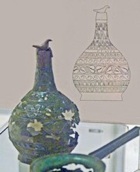
num [i]u
perhaps “Numisius Iunius”
The flask is now is in now the Civic Archeological collection in Palazzo Bianconi, Spello.
Second Punic War (218 - 201 BC)
In his poem ‘Punica’, devoted to the Second Punic War, Silius Italicus (writing in the 1st century AD) has:
-
✴Metaurus of Hispellum killed at at the Battle of Ticinus (218 BC) - see 4:544; and
-
✴included Hipellum among the Umbrian allies of the Romans at the Battle of Cannae (216 BC) - see 8:456
(This page in the excellent website ToposText has links to both of these references). However, Silius was a poet rather than a historia,n and neither of these assertions is corroborated in any other surviving source.
Viritane Settlement in ca. 199 BC (?)
Numerous inscriptions place Hispellum in the Lemonia tribe, although (as discussed below) none of these can be securely dated to a time prior to the triumviral period (42 - 27 BC).
Notwithstanding the lack of earlier epigraphic evidence, Simone Sisani (referenced below, 2007, at pp. 221-3 and in Table 18, p. 224) suggested that this tribal assignation might have reflected the viritane settlement of Roman veterans of Scipio Africanus here at the start of the 2nd century BC. His argument began with the observation that only two Umbrian centres (Attidium and Sentium) were assigned to the Lemonia. He further asserted (at p. 221) that the assignation at Sentinum (modern Sassoferrato) had been made in the political climate in which:
-
✴Fulginia was assigned to the Cornelia (see p. 218); and
-
✴Mevania was assigned to the Aemilia (see p. 219)
and that all three tribal assignations were associated with the settlement of veterans of Scipio Africanus in ca. 199 BC.
Sisani’s hypothesis in relation to Sentinum is based on a series of assumptions. He began by asserting (at p. 221) that:
-
“The terminus ante quem for the viritane settlement of the agro sentinate is provided by the architectural decoration of the temple of Civitalba [some 6 km from the municipium of Sentinum], which was erected shortly after 187 BC and thus soon after the [Scipian settlement programme of] 200-199 BC” (my translation).
He conceded that there is no direct evidence for the dedication of this temple, but suggested that it had probably been dedicated to Jupiter Victor:
-
“... the deity to whom Fabius Rullianus had [vowed a temple at the Battle of Sentinum in 295 BC, which he subsequently built] on the Quirinal [in Rome]. An inscription [CIL VI 438 that was] ... found on the hill attests to the fact that this building had been restored by the consul P. Cornelius L. f .... , without doubt the consul of 236 BC, [Publius Cornelius Lentulus Caudinus] ...” (my translation).
He therefore hypothesised (at p. 222):
-
“... a direct link between [the Cornelii Lentuli] and the construction of the temple of Civitalba, which was built without doubt in the historical context of the viritane settlement carried out by Scipio, which perhaps led to the settlement in the area of other members of this family...” (my translation).
In his view, all this indicated that the Lemonia, like the Cornelia and the Aemilia, was a tribe to which veterans were assigned during the Scipian settlement programme of ca. 199 BC.
I have to say that, while this is a plausible reconstruction of events, it is hardly watertight:
-
✴The subjects of the surviving reliefs from the temple at Civitalba certainly suggest that it celebrated the Roman victory at nearby Sentinum in 295 BC. However, as Sisani pointed out, there is no hard evidence that this temple was dedicated to Jupiter Victor: this hypothesis is based entirely on the circumstantial evidence that, according to Livy, Fabius had vowed to build a temple to Jupiter Victor in Rome after his victory in this battle. If the temple at Civitalba was not dedicated to Jupiter Victor, then there is no reason to associate it with the Cornelii Lentuli.
-
✴There is even uncertainty about their association with Fabius’ temple of Jupiter Victor at Rome: while it is the usually accepted that it was on the Quirinal (as Sisani asserted), some scholars suggest that it was on the site of the “aedes Iovis victoris” that was listed in regio X (Palatium) in the regionary catalogues in the so-called ‘Chronograph of 354 AD’ . Stephen Oakley (referenced below, at p. 327), for example, did not rule this out, albeit that he referred to:
-
“... the slightly more probable view that it was on the Quirinal, [which] depends on [CIL VI 438], a dedication to Jupiter Victor found on the hill.”
-
If Fabius’ temple was not on the Quirinal, then there is no reason to associate it with CIL VI 438 and hence with the Cornelii Lentuli.
-
✴The reliefs from the temple at Civitalba are clearly “Roman” and generally dated to the early 2nd century BC. However, there is (as far as I am aware) no hard evidence for the assertion that the temple itself was built following a programme of veteran settlement in the agro sentinate.
-
✴There is ample evidence (as put forward by Sisani) that members of the Cornelii Lentuli participated in various capacities in the engagements of the Second Punic War. However, there is (as far as I am aware) no hard evidence that any of them subsequently benefitted from the Scipian programme of veteran settlement, whether in the agro sentinate or anywhere else.
Moving now from Sentium to Hispellum, Sisani suggested (at p.223) that:
-
“If the Lemonia, like the Cornelia and the Aemilia, represents one of the tribes in Umbria to which veterans of Scipio were assigned, then the inclusion of Hispellum and Attidium among [the tribes assigned to the Lemonia] allows one to [hypothesise] that the viritane settlement in these districts also took place as part of the same [Scipian] programme” (my translation and my bold italics).
However, some scholars believe that Hispellum belonged to Mevania until ca. 40 BC, when it became the Colonia Julia Hispellum: if so, then it would have belonged (with Mevania) to the Aemilia until its re-assignation to the Lemonia at colonisation.
Status of Hispellum in ca. 90-41 BC
Most of the urban settlements of Umbria (like those elsewhere in Italy) became enfranchised as municipia after the Social Wars of ca. 90 BC and were thereafter administered by quattuorviri. However, the case of Hispellum is uncertain in this respect:
-
✴Filippo Coarelli (referenced below, at pp. 47-8) believed that:
-
“... the urban settlement of Hispellum assumed the dimensions and dignity of a city only with the foundation of the colony [in 41 BC], when it first received city walls. ... The few remains [of the settlement before colonisation] are not indicative of a city; they rather indicate a vicus, which we should recognise as a simple appendage of the [nearby sanctuary at Villa Fidelia, see below]. This sanctuary [and, therefore, the putative vicus of Hispellum] seems to have belonged to another centre that was then more important; that is, to Mevania” (my translation).
-
✴Simone Sisani (referenced below, 2012, at p. 432 and note 117) agreed that the sanctuary at Villa Fidelia had probably belonged to Mevania, passing to Hispellum at colonisation. However, he nevertheless argued (at p. 432 and note 117) that Hispellum, like Mevania, became an autonomous municipium after the Social Wars and that it had this status until colonisation some 50 years later.
From the time of colonisation in 41 BC (discussed in the following page), Hispellum was administered by duoviri. However, the evidence for the period 90-41 BC (discussed below) is inconclusive.
The usual way of establishing municipal status is the presence of epigraphic evidence from the urban centre in question for the magistracy of quattuorviri. Three surviving or recorded inscriptions of this kind could relate to quattuorviri at Hispellum.
-
✴Simone Sisani (2002, referenced below) published a detailed paper on a now-lost inscription (CIL XI 5281) that was on a funerary stele that was found outside Spello in 1773. It read:
L(ucius) Falius L(uci) f(ilius) Tinia
cens(or) pr(aetor) bis IIIIvir
-
In this paper, Sisani asserted that the stele had been found near the church of Santa Luciola outside Spello, but he revised this slightly in a later paper (referenced below, 2012, p. 425, note 90): the correct location was near the present railway station of Cannara (some 6 km northwest of Spello and roughly the same distance, as the crow flies, from Bevagna). There is some uncertainty about the date of this inscription:
-
•By the time of his 2012 paper, Sisani had been able to examine a photograph (illustrated as his Figure 10) that had been taken in the 1990s, when the inscription had been in the deposit of the Commune. This examination confirmed his view that it dated to the period between the presumed municipalisation of Hispellum and its colonisation (i.e., to ca. 90-40 BC). Moreover, he suggested (in the paper of 2002, at pp. 504-5) that Falius had probably been a member of the first college of quattuorviri after municipalisation, and had been responsible for the first municipal census.
-
•The EAGLE database (see the CIL link) gives a wider range of dates, ca. 90-30 BC. A date in the last decade of this range would preclude the possibility that Lucius Falius Tinius had been a quattuorvir of Hispellum.
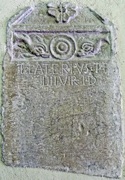
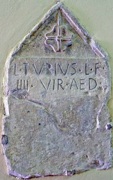
CIL XI 5282: Titus Laterius CIL XI 5288: Lucius Turius
quattuorvir iure dicundo quattuorvir aedillis
-
✴Two other funerary inscriptions (illustrated above), both of which are now in the municipal lapidarium of Spello, commemorate quattuorviri:
-
•CIL XI 5282 (on the left), which came from an unknown location in Spello and which had been reused in casa Donnola there, commemorates Titus Laterius, son of Titus, who had been quattuorvir i(ure) d(icundo); and
-
•CIL XI 5288, which came from an unknown location in Spello and which had been reused in the Collegiata di San Lorenzo there, commemorates Lucius Turius, son of Lucius, who had been quattuorvir aed(illis).
-
Again, there is uncertainty as to their dates:
-
•Simoni Sisani (referenced below, 2012, p. 432, note 117) dated them to the period prior to the formation of the colony at Hispellum.
-
•The EAGLE database (see the respective CIL links) dates them to the 2nd half of the 1st century BC. Again, a date after 41 BC would mean that neither Titus Laterius nor Lucius Turius had been a quattuorviri of Hispellum.
Even if all three inscriptions do pre-date colonisation, this evidence does not conclusively support the case for a municipium at Hispellum:
-
✴CIL XI 5281 (L. Falius Tinia) was found at a site that was roughly equidistant from Hispellum and Mevania; and
-
✴although both CIL XI 5282 (T. Laterius) and CIL XI 5288 (L. Turius) were reused in buildings in Spello, the original location of neither is known.
In any case, a find spot in or near Hispellum would not be conclusive: for example, an inscription (AE 1965, 279a) that commemorated a now-anonymous quattuorvir in the early Augustan period was later embedded near the font of San Bartolomeo, Montefalco: since the area around modern Montefalco certainly belonged to Mevania, it must have commemorated a quattuorvir of Mevania. In the same way, if Hispellum had belonged to Mevania before colonisation, it would have been entirely possible that quattuorviri of Mevania were commemorated here.
Thus, the surviving epigraphic evidence is inconclusive. However, Simone Sisani (referenced below, 2012, at p. 432 and note 117) offered three other pieces of evidence to support his hypothesis that Hispellum had been an autonomous municipium prior to its colonisation:
-
✴He pointed out that the tribal assignation of Hispellum (to the Lemonia) was not shared by any of its neighbours (including Mevania): as noted above, he believed that this assignation dated to the early 2nd century BC,which would mean that Hispellum had a separate identity at that point. However, as Enrico Zuddas and Maria Carla Spadonini (referenced below, at p. 57) pointed out:
-
“ ... [although] at least nine secure epigraphic records [of this tribal assignation have been] found in the city or in its immediate surroundings [none of them can be assigned to the period] before the triumviral age” (my translation).
-
They thus observed that:
-
“... on the basis of current knowledge, one cannot exclude a priori that the [assignation of Hispellum to the Lemonia] was linked to the formation of the colony” (my translation).
-
In other words, Hispellum could have belonged to Mevania and thus been assigned to the Aemilia before colonisation.
-
✴He cited Lawrence Keppie (referenced below, at p. 118), who asserted that:
-
“... in Italy, only a handful of the colonies that were established from 47 BC onwards were planted on what may be termed virgin sites, where full-scale building was a matter of some urgency.”
-
However, it seems to me that there is nothing that precludes the possibility that Hispellum was one of this handful.
-
✴He asserted that the Roman land surveyor Hyginus, in his treatise on the establishment of ‘limites’ (boundaries) of colonies:
-
“... clearly considered [Hispellum] to have existed, in both urban/territorial and institutional terms, at the time of the formation of the colony” (my translation).
-
The text of Hyginus to which Sisani referred has been translated as follows:
-
“Men of old, because of the danger of sudden outbreaks of war, were not satisfied with building walls around their cities, but also chose sites on rough and rocky high ground, where the best defence lay in the very topography of the site. Very many of the precipitous areas adjacent to these cities were not suitable for limites because of the difficulties of the terrain, and were left outside the centuriation [land division], either to provide woods for the community or, if they were barren, to lie unoccupied:
-
-the territory of neighbouring communities was granted to these cities, so that they could have an extent of land appropriate for a colony; and
-
-the decumanus maximus and kardo maximus [of the new settlements] were drawn on the best land;
-
as, for example, in Umbria, in the territory of Hispellum” (translated by Brian Campbell, referenced below, at p. 143).
-
The syntax of this passage has been much-debated, and there is no consensus as to how much of it specifically applied to Hispellum. Even if all of it did - i.e. if Hyginus did conceive of pre-colonial Hispellum as a walled city - it seems to me that he was not necessarily correct in this detail.
In short, the evidence is not conclusive for either hypothesis. Enrico Zuddas (referenced below) recently revisited the debate and concluded that, on the balance of probabilities, the hypothesis that:
-
“.... [Hispellum] had become a municipium after the Social War, and that it had then been transformed into a colony governed by duoviri, is the prudent choice” (my translation).
However, in my view, Filippo Coarelli (referenced below, at pp. 47-8) was more probably correct in suggesting (above) that, prior to colonisation, Hispellum was simply vicus associated with the nearby sanctuary at Villa Fidelia and that both had belonged to Mevania. After all, Simone Sisani has established that the sanctuary almost certainly belonged to Mevania before colonisation (as discussed in the following page): this would surely have an unusual arrangement if Hispellum, which stood on the hill immediately above it, had been an autonomous municipium.
Read more:
S. Sisani, “I Rapporti tra Mevania e Hispellum nel Quadro del Paesaggio Sacro della Valle Umbra”, in:
G. Della Fina (Ed.), “Il Fanum Voltumnae e i Santuari Comunitari dell’ Italia Antica”, (2012) Orvieto (pp. 409-64)
L. Agostiniani et al. (Eds), “Screhto Est: Lingua e Scrittura degli Antichi Umbri”, (2011) Città di Castello
D. Manconi, “Due Capisaldi della Valle Umbra : Spoleto et Spello”, in:
P. Fontaine (Ed.), “L' Étrurie et l'Ombrie avant Rome: Cité et Territoire: Actes du Colloque International, Louvain-la-Neuve, Halles Universitaires, 13-14 February 2004”, (2010) Brussels and Rome
E. Zuddas and M. C. Spadoni, “La Lemonia nella Valle Umbra”, in
M. Silvestrini (Ed.), “Le Tribù Romane: Atti della XVIe Rencontre sur l’ Épigraphie (Bari 8-10 ottobre 2009”, (2010) Bari, at pp. 57-64
S. Sisani, “Fenomenologia della Conquista: La Romanizzazione dell' Umbria tra il IV Secolo a.C. e la Guerra Sociale”, (2007) Rome
S. P. Oakley, “A Commentary on Livy, Books VI-X: Volume IV, Book X”, (2005 ) Oxford
S. Sisani, “Lucius Falius Tinia: Primo Quattuorviro del Municipio di Hispellum”, Athenaeum, 90.2 (2002) 483-505
F. Coarelli, "Il Rescritto di Spello e il Santuario ‘Etnico’ degli Umbri”, in:
“Umbria Cristiana: dalla Diffusione del Culto al Culto dei Santi,” Atti del XV Congresso Internazionale di Studi sull’ Alto Medioevo, (2001) Spoleto, pp. 39-52
B. Campbell, “The Writings of the Roman Land Surveyors: Introduction, Text, Translation and Commentary”, (2000) London
D. Manconi, P. Camerieri and V. Cruciani, “Hispellum: Pianificazione Urbana e Territoriale”, in:
G. Bonamente and F. Coarelli (Eds),“Assisi e gli Umbri nell' Antichità” Assisi (1996) pp. 375-423; the section on the sanctuary is at pp. 381-92
P. Fontaine, “Cités et Enceintes de l'Ombrie Antique” (1990) Brussels
L. Keppie, “Colonisation and Veteran Settlement in Italy (47-14 BC)”, (1993) London
Ancient History: Main Page Colonia Julia Hispellum
Seviri and Seviri Augustales at Hispellum Sanctuary at Villa Fidelia after Colonisation
Sanctuary at Villa Fidelia in the 4th Century AD
Return to the page on the History of Spello.



